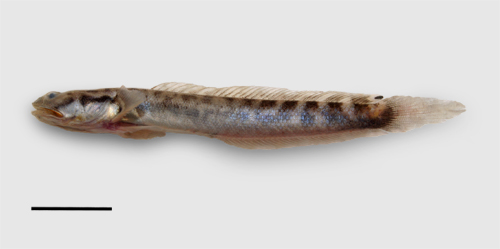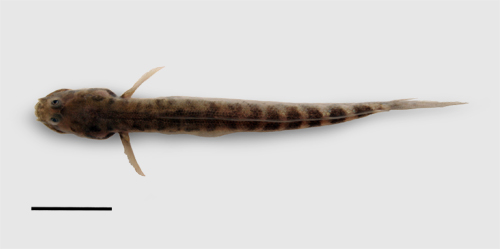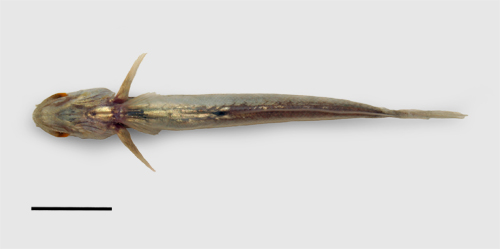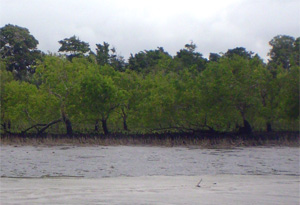Common names:
China |
Chinese Mandarin |
沃氏背眼鰕虎魚, 沃氏背眼鰕虎鱼 (wo shi bei yan xia hu yu - Wo's dorsal-eyed goby)
|
Finland |
Finnish |
borneonkitaryömijä |
Italy |
Italian |
ghiozzo di Wirz* |
Papua New Guinea |
English |
Wirz's goby |
Papua New Guinea |
Purutu's language |
kanipo |
* proposed name
|
|
|
Synonyms:
Apocryptodon wirzi |
Koumans, 1937 |
(senior synonym, original combination) |
Oxuderces wirzi |
(Koumans, 1937) |
(junior synonym, new combination) |
Etymology:
the generic name is a compound form from 'Apocryptes' and the Greek 'odous' (tooth), which refer to the similarity to
the oxudercine genus Apocryptes, and the conspicuous teeth on the upper jaw
the species was named after Dr. P. Wirz, who collected the holotype
|
Maximum recorded length:
105 mm SL (Murdy, 1989)
Live colouration (Polgar et al., 2010: Fly river delta, Papua New Guinea):
ground colour dorsally light brown, greyish on flanks and ventrally whitish;
6-8 vertical and irregular dark brown bars on dorsum, the last 3-4 ones reaching the lateral midline; few dark brown blotches on head, larger on opercles and cheeks; few dark brown spots on dorsum; large dark brown blotch on the base of caudal fin and ventral side of caudal peduncle. D1
translucent; D2 transparent except for 3-4 light brown bars in correspondence to the last 3-4 vertical dorsal bars; a large
dark blue iridescent ocellus near tips of last 4 D2 rays; all other fins transparent; posterior portion
of upper jaw yellow
Colouration on preservation
(Murdy, 1989):
ground colour greenish brown dorsally and ventrally yellowish brown; a discontinuous blue-grey midlateral band which curves ventrally at posterior quarter of D2 and continues onto caudal fin base; small brown spots on dorsum; dark blue markings on cheeks and opercula. D2 with a prominent dark blue ocellus on posteriormost rays; dark blue bar or spots on pectoral fin base; pectoral fins may present small dusky spots ventrally; all other fins transparent. Smaller specimens with 8-10 dorsal bars: only the 3-4 posteriormost ones present in larger ones
Diagnosis (Murdy, 1989; Jaafar and Parenti, 2016):
total D2 elements 29-31; total anal fin elements 27-30; D2 and anal fins basally connected
to caudal fin; 17 branched caudal fin rays; predorsal scales 26-44; 2 recurved canine teeth internal to symphysis
of lower jaw; bifid teeth usually present in lower jaw, sometimes in both jaws; pore posteriorly in interorbital region; basihyal bifid.
The genus is characterised by the presence of a posteriorly directed lamina on the parapophyses of the 4th vertebra and a supraorbital pore
(see drawing)
Diet:
no published study is available
Reproduction:
no published study is available
|
|
Ecological notes:
locally abundant on mudflats, in areas covered by a thin film of water, especially in proximity of creek mouths (Polgar et al., 2010)
middle: Purutu Is., Papua New Guinea: higher mudflat at low tide, in front of a stand of Avicennia lanceolata; An.
wirzi was here abundant
(photo: G. Polgar; 2007)
|
|
|
|
Distribution:
northern Australia and Papua New Guinea; type locality: Papua New Guinea (Murdy, 1989)
|
|
Photographs of Apocryptodon wirzi:
|
A-D: close-ups of An. wirzi in a plastic bag
(photo: G. Polgar,
Purutu Is., Papua New Guinea, 2007)
|
Drawings of Apocryptodon wirzi:
above, left:
cephalic sensory and nasal pores of Apocryptodon spp.: an= anterior nostril;
ao= anterior oculoscapular canal pore; pn= posterior nostril; sp= supraororbital pore (modified from
Murdy, 1989)*; above, right: dorsolateral view of the parapophyseal extension of
the 4th vertebra (An. madurensis: Murdy, 1989, modified)* - * with permission
|








